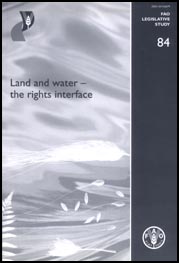
FAO LEGISLATIVE STUDY 84
Land and water -
the rights interface
S. Hodgson
for the
Development Law Service
FOOD AND AGRICULTURE ORGANIZATION OF THE UNITED NATIONS
Rome, 2004
 |
FAO LEGISLATIVE STUDY 84 Land and water - S. Hodgson for the
|
|
|
|
|
The designations employed and the presentation of material in this information product do not imply the expression of any opinion whatsoever on the part of the Food and Agriculture Organization of the United Nations concerning the legal or development status of any country, territory, city or area or of its authorities, or concerning the delimitation of its frontiers or boundaries. |
ISBN 92-5-105214-X
ISSN 1014-6679
All rights reserved. Reproduction and dissemination of material in this information product for educational or other non-commercial purposes are authorized without any prior written permission from the copyright holders provided the source is fully acknowledged. Reproduction of material in this information product for resale or other commercial purposes is prohibited without written permission of the copyright holders. Applications for such permission should be addressed to the Chief, Publishing Management Service, Information Division, FAO, Viale delle Terme di Caracalla, 00100 Rome, Italy or by e-mail to [email protected]
© FAO 2004
2 WHAT ARE LAND TENURE RIGHTS AND WATER RIGHTS?
3 LAND TENURE RIGHTS AND WATER RIGHTS REGIMES COMPARED
3.1.1 Duration
3.1.2 Enforcement against third parties
3.1.3 Enforcement against the state3.2.1 Land ownership rights
3.2.2 Other land tenure rights
3.2.3 Water rights
3.2.4 Conditions and security3.3.1 Measurement and monitoring
3.3.2 The active role of water rights administrations
3.3.3 The reactive role of land tenure rights administrations
3.3.4 Enforcement3.4.1 Water abstraction and use charges
3.4.2 Charging mechanisms and land tenure rights3.5.1 Land tenure rights and international law
3.5.2 Water rights regimes and international law3.6.1 Land tenure rights and markets
3.6.2 Trades and water rights3.7.1 The objectives of water rights reforms
3.7.2 The objectives of land tenure reforms
3.7.3 Reform objectives compared
4 THE “LOST” CONNECTION BETWEEN LAND TENURE RIGHTS AND WATER RIGHTS
4.1 Roman law
4.2 The historical approach of the civil law tradition
4.3 The historical approach of the common law tradition
4.4 The benefits and limitations of the historical approaches
5.1 Formal and informal linkages
5.2 Planning the uses of land and water
5.3 The interface: the role and importance of land tenure rights
6 KEY ASPECTS OF THE RIGHTS INTERFACE
6.1.1 Water rights and irrigation
6.1.2 Land tenure rights and irrigation
6.1.3 The effects of non-co-ordination6.2.1 The risks to groundwater resources
6.2.2 The legal treatment of groundwater
6.2.3 The limitations of the regulatory response6.3 Rights created under customary law
6.3.1 The background
6.3.2 What is meant by customary law?
6.3.3 What are the issues?
6.3.4 Rights and pastoralists
6.3.5 Non-pastoralists6.4.1 Background
6.4.2 Implications for land tenure rights and water rights
7 CONCLUSION AND RECOMMENDATIONS
7.1 Customary law - the fuzzy interface
7.2 Irrigation Management Transfer - moving beyond a rigid interface
7.3 Groundwater - the tightly bound interface
7.4 Concluding Remarks